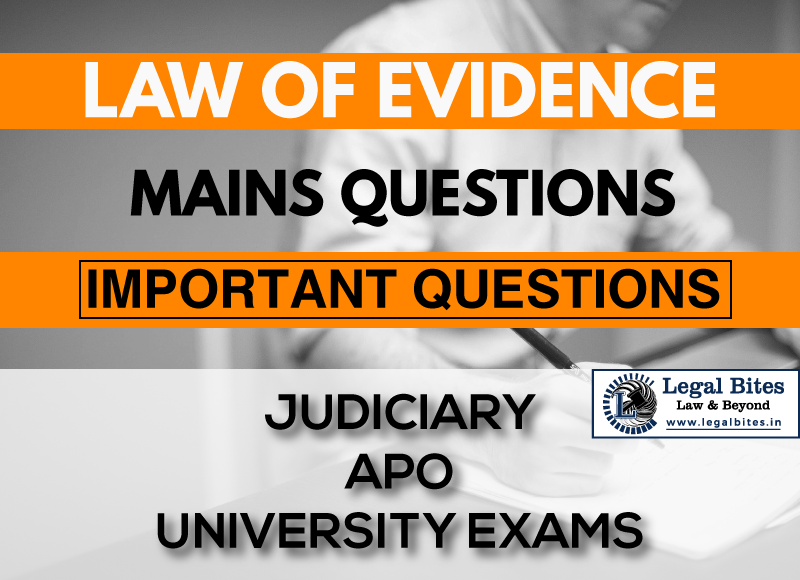Evidentiary value of FIR | Is F.I.R. an ‘evidence’ against the informant, if he (informant) is (himself) made an accused subsequently? Give reasons and also refer to the decision of the Supreme Court, if any, on the point.
Question: Evidentiary value of FIR | Is F.I.R. an ‘evidence’ against the informant, if he (informant) is (himself) made an accused subsequently? Give reasons and also refer to the decision of the Supreme Court, if any, on the point. Find the answer to the mains question only on Legal Bites. Evidentiary value of FIR | [Is F.I.R. an… Read More »
;
Question: Evidentiary value of FIR | Is F.I.R. an ‘evidence’ against the informant, if he (informant) is (himself) made an accused subsequently? Give reasons and also refer to the decision of the Supreme Court, if any, on the point. Find the answer to the mains question only on Legal Bites. Evidentiary value of FIR | [Is F.I.R. an ‘evidence’ against the informant, if he (informant) is (himself) made an accused subsequently? Give reasons and also refer to the decision of the...
Question: Evidentiary value of FIR | Is F.I.R. an ‘evidence’ against the informant, if he (informant) is (himself) made an accused subsequently? Give reasons and also refer to the decision of the Supreme Court, if any, on the point.
Find the answer to the mains question only on Legal Bites. Evidentiary value of FIR | [Is F.I.R. an ‘evidence’ against the informant, if he (informant) is (himself) made an accused subsequently? Give reasons and also refer to the decision of the Supreme Court, if any, on the point.]
Answer
The information given by any person to the police of an offence which the police is empowered to investigate under the Code (Cognizable Offence), is called ‘first information’.
Under Section 154, this information must be reduced to writing and the police officer must make a note of the receipt of this information in a diary maintained by him every day. This written information is called the “First Information Report” (FIR).
It can be said that FIR is not a substantive piece of evidence and cannot be relied on by the prosecuting agency for the conviction of the accused. FIR is not recorded on oath and is a mere statement made to the police without any swearing. Further, its veracity is not tested by cross-examination.
In the case of State of Gujarat v. Anirudh Singh AIR 1997 (SC) 2780, the SC has held that the first information report is never treated as a substantive piece of evidence. It can only be used for corroborating or contradicting its maker when he appears in Court as a witness. Its value must always depend on the facts and circumstances of a given case. The first information report can only discredit the testimony of the maker thereof. It can by no means be utilized for contradicting or discrediting the other witnesses who obviously could not have
The landmark case for considering the evidentiary value of FIR given by an accused is Aghnoo Nagesia v. the State of Bihar [ AIR 1966 SC 119] The court, in this case, held that:
- FIR given by the accused is categorically inadmissible as evidence.
- If the FIR given by the accused is non-confessional in nature, it can still be admitted by the maker of the FIR in the court. However, unless specifically admitted, the FIR of the accused cannot be used against him.
- If it is confessional in nature and will expose the accused to criminal charges, it will become inadmissible except as provided under Section 27 of the Evidence Act. Section 27 allows the confessional statement of the accused to be used for further investigation for discovery if new and relevant facts and if any fact is discovered, it can be used in court.
- If an FIR is partly confessional and partly non-confessional, it is entirely inadmissible in court. However, if the no-confessional part is absolutely exclusive of the confessional part, it can be a relevant fact under Section 18 of the Evidence Act and if admitted by the maker under Section 21, can be admissible as evidence.
In certain circumstances, the FIR itself becomes a substantive piece of evidence. Under Section 32 of the Evidence Act; if the person making the FIR is dead or cannot be found or if his attendance cannot be procured without unnecessary delay in the trial, then in only that case an FIR becomes a substantial piece of evidence.
If the FIR mentions the details of the accused, it can be used to convict him though it cannot be the sole reason to convict him. Moreover, if the FIR is a part of a transaction that is admissible in court, the FIR becomes admissible. A prosecution case cannot be thrown out on the mere ground that in the first information report an altogether different version was given by the informant.
Important Mains Questions Series for Judiciary, APO & University Exams
- Law of Evidence Mains Questions Series Part-I
- Law of Evidence Mains Questions Series Part-II
- Law of Evidence Mains Questions Series Part-III
- Law of Evidence Mains Questions Series Part-IV
- Law of Evidence Mains Questions Series Part-V
- Law of Evidence Mains Questions Series Part-VI
- Law of Evidence Mains Questions Series Part-VII
- Law of Evidence Mains Questions Series Part-VIII
- Law of Evidence Mains Questions Series Part-IX
- Law of Evidence Mains Questions Series Part-X

